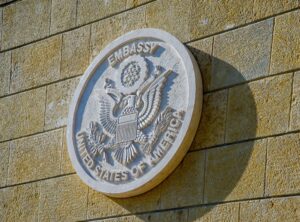Airports Commission states that expanding either Gatwick or Heathrow would have a negative air quality impact, but plans more detailed modelling
The independent Airports Commission has launched a consultation on options for a new runway at either Heathrow or Gatwick, alongside a report which assesses the possible air quality impacts of each scheme.
And, while the Commission has not yet made any specific recommendations, it states that expanding either Gatwick or Heathrow would in either case have a negative impact on air quality, with all proposed schemes requiring expansions to local road networks to accommodate increased road traffic.
Two of the proposed schemes would see an expansion of Heathrow AirportHowever, while the Commission believes the air quality modelling information it has so far provided gives a “sufficient evidential basis for consultees to express their views”, it has yet to complete its full detailed modelling of the air quality impacts of airport expansion.
Launched this week (November 11), the consultation will run for 12 weeks and closes on February 3 2015. It concerns three options for a new runway in the South East of England: a second runway at Gatwick; a North West runway at Heathrow; and the extension of the Heathrow Northern runway.
The Commission forecasts a third runway at Heathrow would cost £18.6 billion, extending the northern runway would cost £13.5bn, and a second Gatwick runway would cost £9.3bn (£7.4bn).
Chair of the Airports Commission, Sir Howard Davies, said that it had “not yet taken a view on which proposal strikes the most effective balance between the assessment criteria” but that the consultation provided an opportunity for the evidence to be “examined, challenged and improved”.
Commenting on the consultation launch, Sir Howard said: “Responses to this consultation will be a valuable addition to our evidence base and will directly inform our recommendation to the government when we publish our final report in the summer of 2015.”
Heathrow
According to the Airports Commission, both local air quality objectives and EU limits thresholds “are at risk of exceedance at a small number of monitoring sites in the local area” under the two schemes proposed for Heathrow.
The report adds that for both schemes “there is clearly a substantial negative impact of the scheme on air quality, unless forceful mitigation measures are implemented”.
King’s College London annual nitrogen dioxide monitoring data for 2010 shows that levels of the pollutant breached annual limits of 40 microgrammes per cubic metre in and around Heathrow, which scientists at the university have said is largely due to road traffic.
Furthermore, a King’s College map depicting air pollution levels in Greater London shows that Heathrow has the highest levels of nitrogen dioxide outside the centre of the capital.
According to the Airport Commission’s report published this week: “significant works are needed on the roads around the airport site to accommodate its expanded footprint including putting the M25 into a tunnel.”
The report states that the management of congestion on the M25 and the M4 near Heathrow “will be a significant issue and infrastructure (including widening), demand management or a combination of both may be required”.
However, it adds that “the majority of these strategic road works would be needed even without any expansion, given baseline expectations about increase in demand”.
In addition, the report also suggests that some additional widening of the M4 may be needed as a result of expansion, but that “it may be possible to avoid of reduce this through mitigation measures”.
The Mayor of London is opposed to Heathrow airport expansion and has previously highlighted the impacts on air quality of such a scheme, as has Friends of the Earth London campaigner Jenny Bates, who said this week that expanding Heathrow “would bring more noise and pollution to local communities”.
Gatwick
The M23 motorway near Gatwick AirportAdding a second runway at Gatwick airport would require land take in the Langley Green, Pound Hill North and Northgate wards of Crawley, plus the Rusper and Colgate ward within the district of Horsham.
Expansion of the airport at Gatwick would, according to the report, have a “negative impact on a range of other local environmental factors, including air quality” and adds that “impacts in some cases will never be entirely mitigated”.
However, the report states that with regards to air quality “further work is required to fully quantify the limited risks”.
Regarding the impacts on road traffic around Gatwick, the report states: “Planned and anticipated (though uncommitted) investment on the M23 and M25 is also forecast to provide sufficient capacity to accommodate growth in road traffic from the expanded airport. A range of investments in the local road network would be needed to enable the delivery of the second runway and associated infrastructure.”
Detailed modelling
While “high-level air quality modelling” enabling a “comparison of the scale of impacts and risks” associated with each option has been presented for consultation, the Commission intends to supplement this at a future date with “more detailed dispersion modelling”.
According to the Commission’s report this week, the dispersion modelling “will provide greater assurance in respect of the air quality implications of each proposal and the scope for mitigation”
But, the Commission said that the “range of inputs required and the complexity of this work mean that it has not been possible to carry it out in advance of consultation”.
The report adds: “It is acknowledged it would have been preferable to have available the outcome of more detailed modelling exercises prior to consultation. On balance, however, the Commission considers that it is better to launch the consultation phase of its work at the present time (enabling sufficient time for participation in the process and for consideration of the outcome of those responses), than to hold off the consultation process in an attempt to achieve a firmer foundation for its air quality assessments.”













Air pollution has always been the insurmountable problem Heathrow expansion has faced. By delaying pollution modelling exercises until now, it is clear that the Davies Commission is trying its best to justify the unsustainable expansion of Heathrow. The ridiculous concept that dispersion through variable weather patterns (that are changing due to climate change) can be defined is as fanciful as the concept that Heathrow can be expanded without significant environmental costs.
The headline development costs are misleading. The only part of development costs that should be considered by Davies are those involving public expenditure and not those of the private companies (overseas owners) who own the airports.